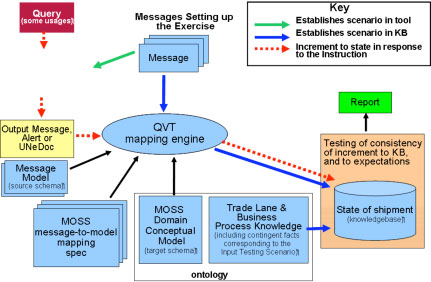Architecture for MOSS Conformance Demonstration
 This figure depicts Testbed system architecture for the Materials Off-Shore Supply Chains (MOSS). The principle components of the system:
This figure depicts Testbed system architecture for the Materials Off-Shore Supply Chains (MOSS). The principle components of the system:
- A System Under Test : a supply chain technology provider's tool that is the subject of testing. This is, of course, not actually a component of the testbed, but here for expository purposes.
- Messages Setting up the Exercise : EDI or XMLbased messages that correspond to some scenario, and some testing purpose, and are, in the business process, typically conveyed to the system under test.
- Output Message : an EDI or XMLbased message that is emitted from the system under test and is the subject of the conformance analysis peformed by the testbed.
- QVT Mapping Engine : a structural information mapping engine that maps message content (messages setting up the exercise, and the output message) to the knowledge base.
- Message Models : MOFbased models of the message types, one for each message type of the messages setting up the exercise, and the output message. These are each source schema for the mapping of one message type by the mapping engine.
- MOSS Conceptual Model : A UML model, consisting of class diagrams that describes object types and relationships in long distance supply chains. This model is the target schema of the mapping engine (in all uses) and is translated to first order sentences to provide portions of the ontology used by the first order.
- Trade Lane and Business Process Knowledge : Additional axioms (additional to those generated from the UML model) that provide constraints and ground facts (e.g. that there is a port in Oakland, California) that are relevant to the scenario.
- Knowledge base : that is populated by the ground facts generated by mapping messages to a population conforming to the conceptual model (role of the mapping engine), and by ground facts provided by the Trade Lane and Business Process Knowledge.
- MOSS Message to Model Mapping Specs : QVT mapping specifications that map message content (conforming to the message model source schema) to a conceptual model population (conforming to the conceptual model, the mappings target schema).
- Report : a report generated by evaluation of the axioms, (or in the December time frame, the OCL constraints or Datalog queries). The report describes the assessment of conformance and completeness made of the system under test's ability to generate the output message. In the processing of an exercise, the system under test and the testbed itself are both provided with messages setting up the exercise. The system under test will use these to establish the context of the scenario in its internal representation. The testbed will similarly set up the context – it does this by translating the message content into statements that become part of the knowledge base (State of shipment in Figure 3). The means by which it performs this translation is a mapping performed by the QVT mapping engine. The source schema to this mapping is a message model corresponding to the message being processed (i.e. each messages setting up the exercise, in turn). The target schema of these mappings is the conceptual model. With this work performed, the tool under test may then generate the output message. Like the messages setting up the exercise, this message is processed through the mapping engine to statements that become part of the knowledge base. Unlike the content derived from the messages setting up the exercise, however, these statements may contradict statements made previously. Contradictions indicate nonconformance to the recommended practice, and are the subject of the Report generated. Omission of information that is mandatory in the message will also be noted in the mapping of the output message. The output message may introduce content not found in the previous messages of the business process. For example, a load tender message may specify dimensions and weights of packages - this information is not found in the DELJIT message that initiated the shipment and set up the exercise. To enable testing of these items, the testbed must be made aware that new information is being introduce, and it must be provided with the details. This is accounted for as Trade Lane and Business Process Knowledge (And thus the verbiage "including contingent facts corresponding to the Input Testing Scenario" in this Figure.)
The test exercise will provide direction to the operators of the tool under test with regard to such issues.
Created December 8, 2011

